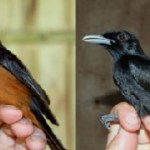speciation
Life has been growing on Earth for about 4 billion years, and during that time there have been a handful of mass extinctions that have wiped out a large percentage of complex lifeforms. Asteroid impact, volcanic eruption, climate change, anoxia, and poison have dispatched untold numbers of once-successful species to total oblivion or a few lucky fossils. Species also die off regularly for much less spectacular reasons, and altogether about 98% of documented species no longer exist.
Cry me a river, you say, without all that death there would have been no gap for vertebrates, for…
One of the reasons I've learned to stay away from debates about "what is a species" is that practical species definitions (i.e., something we can use to classify critters) do a lousy job of describing the process of speciation, while conceptually sound species definitions (ones that describe the speciation process) are usually miserable when you actually try to classify organisms. Why? Because delineating species implies (and requires) sharp biological breaks that might not exist. Case in point, the Eastern coyote:
Two separate teams of researchers studying the genes of coyotes in the…
(from here)
One of the models for the evolution of new species is allopatric speciation, where a small isolated population diverges from a larger ancestral population. Many of these peripheral populations become extinct, but some persist and give rise to new species if they can remain reproductively isolated (unable to breed with each other). Lots of things can cause populations to diverge to the point where they can't interbreed, but one key factor is the divergence in sexual signals--that is, individuals don't mate with each other because they don't think they are in the same species (…
tags: What, If Anything, Is Big Bird?, taxonomy, taxonomy, evolution, Grandicrocavis, Big Bird, flightless birds, ratites, humor, comedy, science humor, dinosaur humor, Mike Dickison, PechaKucha, Christchurch, streaming video
Years ago, when Zoologist Mike Dickison was in the early stages of his PhD, he gave a joke presentation at a graduate student conference on the taxonomy and evolution of a giant flightless bird. It was the sort of thing you'd see at any conference on avian evolution: a Latin name, reconstructed skeleton, possible place on the great evolutionary tree of birds. The tone…
tags: Evolution in Action by AMNH, Congo River, fishes, AMNH, American Museum of Natural History, evolution, variation, biodiversity, Melanie Stiassny, streaming video
This video tells the story of speciation in Central Africa's roiling, rapid Lower Congo River. This river is home to an extraordinary assortment of fish -- many truly bizarre. This new video by Science Bulletins, the American Museum of Natural History's current-science video program, features Museum scientists on a quest to understand why so many species have evolved here. Follow Curator of Ichthyology Melanie Stiassny and her…
tags: Inside the Collections: Ichthyology at AMNH, fishes, AMNH, American Museum of Natural History, evolution, variation, biodiversity, Melanie Stiassny, streaming video
This video is the first of a new series of behind-the-scenes looks at the collections at the American Museum of Natural History. In this video, Melanie Stiassny, Axelrod Research Curator in the Department of Ichthyology, takes us through the Museum's vast collection of fishes.
The Department of Ichthyology, one of the four departments within the Museum's Division of Vertebrate Zoology, houses a collection that comprises more…
We saw that the littlest differences can lead to dramatic variations when we looked at the wide variety in dogs. But despite their differences, all breeds of dogs are still the same species as each other and their ancestor. How do species split? What causes speciation? And what evidence do we have that speciation has ever occurred?
Critics of evolution often fall back on the maxim that no one has ever seen one species split into two. While that's clearly a straw man, because most speciation takes far longer than our lifespan to occur, it's also not true. We have seen species split, and we…
A grey mouse lemur (Microcebus murinus). Image from Wikipedia.
Charles Darwin's visit to the Galapagos Archipelago has been celebrated time and again for its influence on his evolutionary thoughts, but I have to wonder what would have happened if the Beagle skipped the Galapagos and visited Madagascar instead. What would Darwin have made of the animals which had been evolving in splendid isolation on the African island? Would "Darwin's lemurs", rather than Darwin's finches, be among the most recognizable icons of evolution?
Answers to such questions are beyond our grasp, but the diverse…
tags: reptiles, chameleon species, herpetology, Chris Raxworthy, research, American Museum of Natural History, AMNH, New York City, field research, nature, travel, Madagascar, speciation, streaming video
With Madagascar containing nearly two-third's of the world's chameleon species, Christopher Raxworthy, Associate Curator of Herpetology at the American Museum of Natural History, recently embarked on an expedition to the island in search of these special lizards. His hope was to track down the lined-chameleon in order to further study speciation on Madagascar.
Having recently returned from…
Toads are an evolutionary success story. In a relatively short span of time, they diversified into around 500 species and spread to every continent except Antarctica. Now, Ines van Bocxlaer from Vrije University has uncovered the secrets of their success. By comparing the most home-bound toads with the most invasive ones, she has outlined seven qualities that enabled these amphibians to conquer the world. In a common ancestor, these seven traits came together to create an eighth - a pioneer's skill are colonising new habitats.
Some, like the harlequin toads, are restricted to such narrow…
In the forests of Germany live large numbers of blackcaps, a small species of songbird. They all look very similar, but they actually belong to two genetically distinct groups that are becoming more disparate with time. For the moment, the best way to tell them apart is to wait for winter. As the cold sets in, one group of blackcaps flies southwest to Spain, while a smaller group heads northwest towards Britain.
If the prospect of spending winter in Britain rather than Spain seems odd to you, you're not alone. Indeed, blackcaps were hardly ever ventured across these shores before the 1950s.…
tags: new species, biology, botany, orchid, tiniest orchid, Orchidaceae, Platystele, Lou Jost
A close-up of the world's smallest orchid, at just over 2mm from petal tip to petal tip.
Image: Lou Jost.
The world's smallest orchid was discovered recently in a mountainous nature reserve in Ecuador by American botanist Lou Jost. Dr. Jost, a former physicist, now works as a mathematical ecologist, plant biogeographer and conservation scientist, and is one of the world's most expert orchid hunters. In the previous decade, Dr. Jost discovered 60 new species of orchids and 10 other new plant…
Walk through the rainforests of Ecuador and you might encounter a beautiful butterfly called Heliconius cydno. It's extremely varied in its colours. Even among one subspecies, H.cydno alithea, you can find individuals with white wingbands and those with yellow. Despite their different hues, they are still the same species... but probably not for much longer.
Even though the two forms are genetically similar and live in the same area, Nicola Chamberlain from Harvard University has found that one of them - the yellow version - has developed a preference for mating with butterflies of its own…
tags: Tree of Life, conservation, biodiversity, ecology, evolution, biology, statistics, teaching, streaming video
This video presents a very brief glimpse into what I do as a professional researcher studying "my birds" -- the parrots of the South Pacific Ocean (during those rare and beautiful times when I actually have a job!!). To say the least, it fills me with intense longing to reclaim my long lost life.
tags: Tree of Life, conservation, biodiversity, ecology, evolution, biology, statistics, teaching, streaming video
This video presents a very brief glimpse into what I do as a professional researcher studying "my birds" -- the parrots of the South Pacific Ocean (during those rare and beautiful times when I actually have a job!!). It features interviews with one of the scientists whom I worked with when I was in grad school at the University of Washington: Scott Edwards, who now is at Harvard University. To say the least, this video fills me with intense longing to reclaim my long lost life…
Thomas Mailund on Doubts about complex speciation between humans and chimpanzees:
Two patterns from large-scale DNA sequence data have been put forward as evidence that speciation between humans and chimpanzees was complex, involving hybridization and strong selection. First, divergence between humans and chimpanzees varies considerably across the autosomes. Second, divergence between humans and chimpanzees (but not gorillas) is markedly lower on the X chromosome. Here, we describe how simple speciation and neutral molecular evolution explain both patterns. In particular, the wide range in…
This article is reposted from the old Wordpress incarnation of Not Exactly Rocket Science.
"Congratulations, it's a stunted, malformed, necrotic hybrid!" Those aren't really the words that new parents want to hear but thankfully, plants aren't in a position to be that upset.
In several species of plants, a surprising number of offspring turn out to be malformed hybrids that quickly wither and die. Now, Kirsten Bomblies and colleagues from the Max Planck Institute for Developmental Biology have found out why.
Two genes, one passed down by each parent, ignite an reaction in the hybrid…
In Mexico's Cueva del Azufre (the Sulphur Caves), a small fish called the shortfin molly (Poecilia mexicana) is on the way to becoming two separate species. Those that live in the dark interior of the caves are very different to their relatives that swim in the bright, surface waters. They have lighter colours and live more solitary lives. Their eyes are smaller, less sensitive and have lower levels of light-sensitive pigment. Instead, they rely instead on a hypersensitive pressure detector - the lateral line - to sense disturbances in the water.
Their differences aren't just skin deep…
tags: lories, Loriinae, Loriidae, ornithology, molecular biology, natural history museums
A young pair of Meyer's Lories (Lorikeets), Trichoglossus flavoviridis meyeri.
Image: Iggino [larger view].
"Can you help us identify a mystery lory in our collection?"
I was pleasantly surprised to find this email request from Donna Dittmann, Collections Manager and Museum Preparator for the Section of Genetic Resources at Louisiana State University Museum of Natural Science in Baton Rouge, Louisiana.
"Sure," I wrote back. "Send it to me and I'll see what I can do."
I, and some of my lories,…
tags: evolutionary biology, speciation, species flocks, molecular phylogeny, behavioral ecology, Synodontis species, squeaker catfish, cuckoo catfish, Lake Tanganyika, peer-reviewed paper
The Cuckoo Catfish, Synodontis multipunctatus [Siluriformes: Mochokidae].
This is the only fish that is a known brood parasite.
This is one of the species included in this newly-published study.
Image: orphaned.
One of the groups of fishes that I worked with as an aquarist for nearly my entire life are the synodontids, often known as "squeaker catfish" for their ability to make high-pitched sounds.…

